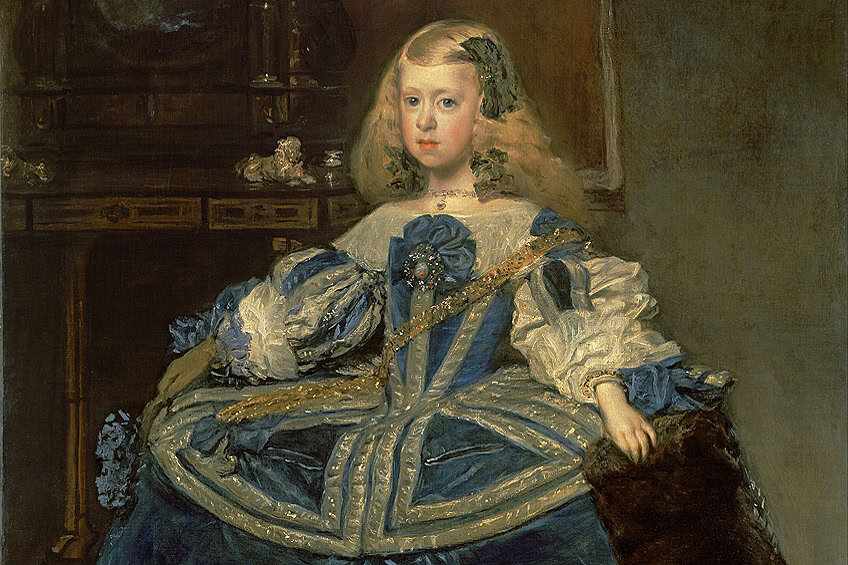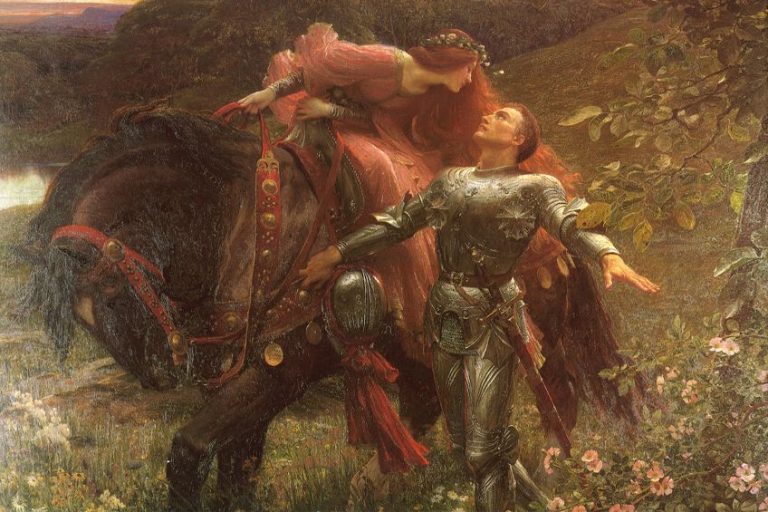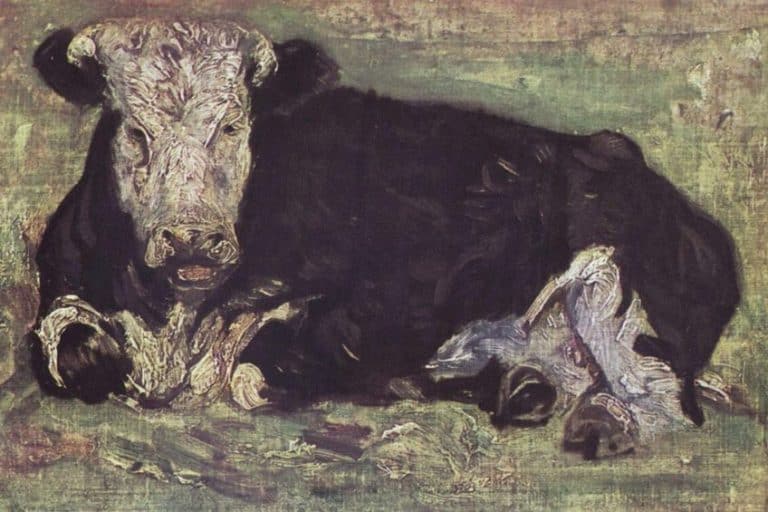Infanta Margarita Teresa in a Blue Dress by Diego Velázquez
Diego Velázquez’s “Infanta Margarita Teresa in a Blue Dress” stands as one of the Spanish master’s most recognizable portraits, painted in 1659 just one year before his death. The artwork depicts the eight-year-old daughter of King Philip IV and Mariana of Austria, captured with remarkable skill and sensitivity that showcases Velázquez’s unparalleled ability to portray royal subjects with both grandeur and humanity. Once thought lost, this significant painting was rediscovered in 1923 and now resides in the Kunsthistorisches Museum, where it continues to captivate viewers with its technical brilliance and historical importance.
Key Takeaways
- The portrait was created in 1659, depicting the eight-year-old Spanish Infanta Margarita Teresa in courtly attire.
- The painting was considered lost for many years until its rediscovery in 1923, albeit in a cut-down form.
- Velázquez completed this masterpiece during his final year of life, demonstrating his mature artistic technique and status as the leading court painter for Philip IV of Spain.
| Artist | Diego Velázquez (1599 – 1660) |
| Date Painted | 1659 |
| Medium | Oil on canvas |
| Genre | Portrait |
| Period / Movement | Baroque |
| Dimensions (cm) | 127 x 107 |
| Series / Versions | One of several portraits of Infanta Margarita Teresa |
| Where Is It Housed? | Kunsthistorisches Museum, Vienna |
| What It Is Worth | Considered priceless; not for sale |
Subject of the Painting: Infanta Margarita Teresa
The central figure in Velázquez’s masterpiece is Infanta Margarita Teresa, daughter of King Philip IV of Spain and Mariana of Austria. Painted in 1659, this portrait captures the young princess at eight years old, just one year before the artist’s death.
Margarita Teresa wears an elegant blue silk dress adorned with decorative elements, demonstrating the formal court attire expected of Spanish royalty. Her solemn expression reflects the composed demeanor expected of royal children, despite her young age.

The Infanta held significant political importance as a Habsburg princess. Years after this portrait, at the age of fifteen, she would marry her uncle, Leopold I, highlighting the dynastic marriages common among European royalty during this period.
This portrait is one of several Velázquez created of the Infanta throughout her childhood. While many know her from her appearance in Velázquez’s masterpiece “Las Meninas,” this blue dress portrait shows her in a more traditional formal pose.
The painting was once believed lost before being rediscovered. It now resides in the Kunsthistorisches Museum alongside a portrait of her younger brother, Philip Prosper, also painted by Velázquez in the same year.
Analysis of the Artwork
Velázquez’s “Infanta Margarita Teresa in a Blue Dress” showcases the artist’s masterful technique and careful attention to detail. The painting demonstrates his unique approach to color, light, and symbolic elements typical of Spanish Baroque portraiture.
Symbolism and Themes
The portrait of eight-year-old Infanta Margarita Teresa carries significant political and dynastic symbolism. As the daughter of King Philip IV, her formal portrayal reflects her royal status and importance as a potential diplomatic asset through marriage alliances.
The richness of her attire symbolizes the wealth and power of the Spanish Habsburg dynasty, despite the empire’s declining influence at that time. Her poised stance and direct gaze convey royal dignity unusual for a child.
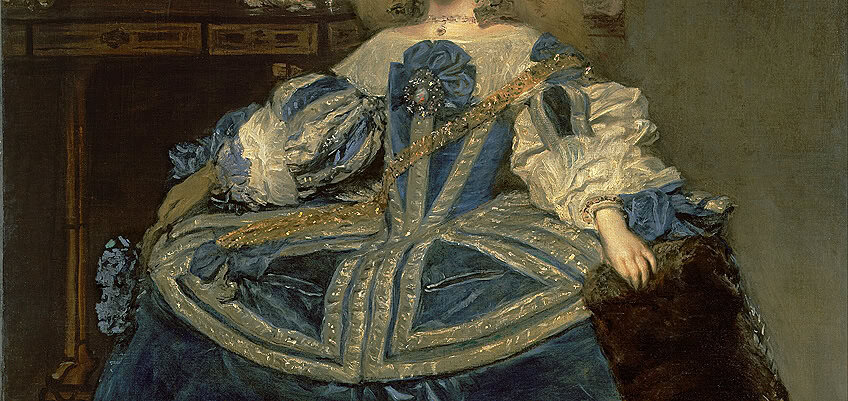
The clock visible in the background serves as a memento mori element, a subtle reminder of mortality common in Baroque art. This creates an interesting contrast with the youth and innocence of the subject.
The meticulous rendering of luxurious fabrics and jewelry reinforces the Infanta’s elevated social position and the ceremonial nature of court portraiture.
Use of Color and Composition
The striking blue dress forms the focal point of the composition, drawing immediate attention to the Infanta. This brilliant azure hue was achieved using expensive ultramarine pigment, emphasizing the subject’s royal status.
Velázquez employs a restrained color palette that allows the blue to stand out dramatically against the neutral background. The artist’s masterful handling of light creates a luminous quality that enhances the dress’s fabric and the Infanta’s pale complexion.
The composition follows formal court portrait conventions with its frontal pose, but Velázquez softens this rigidity through subtle asymmetries and natural lighting effects.
White accents in the collar and sleeves create visual balance and draw attention to the Infanta’s face. The carefully structured space around the figure gives her presence a sense of dignity without overwhelming the viewer.
Techniques and Style
This 1659 work demonstrates Velázquez’s mature style, characterized by loose, confident brushwork combined with precise detail where needed. His technique of applying paint in varied textures creates visual interest and tactile realism.
The artist’s selective focus approach is evident—areas of importance like the face and hands receive meticulous attention, while background elements are rendered more loosely. This technique directs the viewer’s gaze and creates depth.
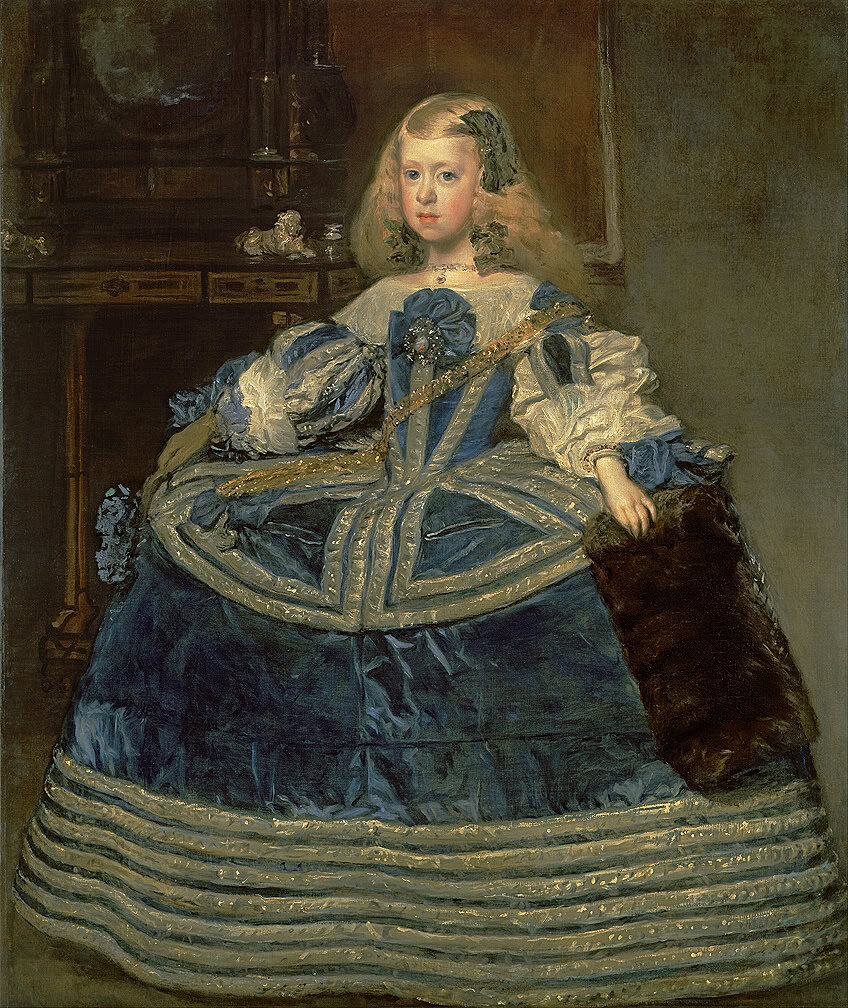
Velázquez masterfully captures the material qualities of different surfaces—the silky sheen of the blue dress, the transparency of lace, and the hardness of jewels. His handling of fabrics was particularly admired.
The painting showcases his signature atmospheric perspective, with subtle gradations of light creating a natural sense of three-dimensional space. This work exemplifies the Spanish Baroque’s distinctive blend of naturalism and grandeur.
Historical Context
Infanta Margarita Teresa in a Blue Dress was created in 1659, during the Spanish Golden Age and the European Baroque period. This era was characterized by dramatic artistic expressions, heightened emotionalism, and technical mastery—all qualities exemplified in Velázquez’s work.
As one of Velázquez’s final paintings before his death in 1660, the portrait captures the eight-year-old Infanta Margarita Teresa, daughter of King Philip IV and his second wife Mariana of Austria. The Infanta held significant political importance as a potential heir to the Spanish throne during a period of declining Spanish power.
The painting emerged in a time when Spain’s global influence was waning, following the Thirty Years’ War and ongoing conflicts with other European powers. The Spanish Habsburg dynasty, to which Margarita Teresa belonged, was increasingly concerned with securing political alliances through strategic marriages.
Margarita Teresa herself would later become Holy Roman Empress through her marriage to her uncle, Emperor Leopold I—a union arranged to strengthen ties between the Spanish and Austrian branches of the Habsburg family. This portrait was likely created as part of a series sent to the Imperial court in Vienna to document her growth and appearance.
Velázquez, as the leading court painter, was tasked with creating these official royal portraits that served both artistic and diplomatic functions. His position allowed him unique access to the royal family, resulting in intimate yet formal depictions of the Spanish court.
Cultural and Artistic Influence
Velázquez’s portrait of Infanta Margarita Teresa in a Blue Dress has exerted significant influence on Western art since its creation in 1659. The painting demonstrates Velázquez’s mastery of light, color, and composition during his final period.
The portrait has inspired numerous artists across centuries, including Thomas Cole, a prominent American landscape painter of the Hudson River School. While Cole is best known for his allegorical landscape series, his study of European masters like Velázquez informed his approach to depicting nobility and innocence.
The New York Historical Society featured the influence of Spanish royal portraiture on American art in a special exhibition that highlighted how Velázquez’s techniques shaped transatlantic artistic developments. The exhibition emphasized the portrait’s unique handling of blue pigments and atmospheric depth.

Art historians frequently cite this work when discussing the destiny of empires as embodied in royal portraiture. The Infanta’s portrait, created just before Velázquez’s death, captures the Habsburg dynasty at its twilight, inadvertently documenting a royal line approaching its eventual destruction.
Critics note the contrast between the delicate rendering of the eight-year-old princess and the political realities she faced as a pawn in diplomatic marriages. Her blue dress, expertly rendered with varying tones and textures, has become an iconic example of Velázquez’s ability to transform fabric into a vehicle for emotional expression.
The portrait’s influence extends to contemporary fashion, photography, and film, where its composition and color palette continue to inspire creative works across multiple disciplines.
Frequently Asked Questions
Velázquez’s portrait of Infanta Margarita Teresa showcases his masterful technique and serves as an important historical record of the Spanish royal family.
What is the significance of ‘Infanta Margarita Teresa in a Blue Dress’ within Diego Velázquez’s body of work?
“Infanta Margarita Teresa in a Blue Dress” was one of Velázquez’s final paintings, completed in 1659, just one year before his death. The portrait demonstrates his mature style and technical mastery, serving as a culmination of his decades of experience as the Spanish court’s principal painter.
How does the depiction of Infanta Margarita Teresa compare across Velázquez’s different paintings?
This portrait shows the Infanta at age eight, contrasting with his earlier depictions of her at younger ages, including her famous appearance in “Las Meninas.” The blue dress portrait reveals Velázquez’s consistent ability to capture the Infanta’s likeness while showing her growth and developing personality through different stages of childhood.
What historical context is relevant to the understanding of ‘Infanta Margarita Teresa in a Blue Dress’?
The portrait was created during a significant political period when the Infanta was being considered as a potential bride for her uncle, Holy Roman Emperor Leopold I. This painting, once believed lost, serves as both a royal portrait and a diplomatic tool, showcasing the young princess to potential allies during negotiations that would eventually lead to her marriage to Leopold at age fifteen.
Isabella studied at the University of Cape Town in South Africa and graduated with a Bachelor of Arts majoring in English Literature & Language and Psychology. Throughout her undergraduate years, she took Art History as an additional subject and absolutely loved it. Building on from her art history knowledge that began in high school, art has always been a particular area of fascination for her. From learning about artworks previously unknown to her, or sharpening her existing understanding of specific works, the ability to continue learning within this interesting sphere excites her greatly.
Her focal points of interest in art history encompass profiling specific artists and art movements, as it is these areas where she is able to really dig deep into the rich narrative of the art world. Additionally, she particularly enjoys exploring the different artistic styles of the 20th century, as well as the important impact that female artists have had on the development of art history.
Learn more about Isabella Meyer and the Art in Context Team.
Cite this Article
Isabella, Meyer, “Infanta Margarita Teresa in a Blue Dress by Diego Velázquez.” Art in Context. April 17, 2025. URL: https://artincontext.org/infanta-margarita-teresa-in-a-blue-dress-by-diego-velazquez/
Meyer, I. (2025, 17 April). Infanta Margarita Teresa in a Blue Dress by Diego Velázquez. Art in Context. https://artincontext.org/infanta-margarita-teresa-in-a-blue-dress-by-diego-velazquez/
Meyer, Isabella. “Infanta Margarita Teresa in a Blue Dress by Diego Velázquez.” Art in Context, April 17, 2025. https://artincontext.org/infanta-margarita-teresa-in-a-blue-dress-by-diego-velazquez/.


